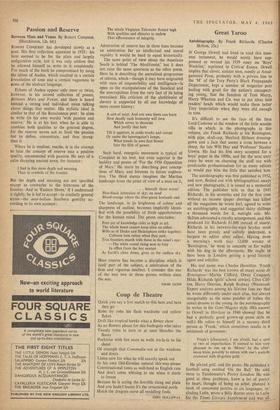Great Yaroo
IF George Orwell had lived to read this inno- cent testament, he would surely have sup- pressed or revised his 1939 essay on 'Boys' Weeklies,' reprinted in Critical Essays. Orwell implies that clever, sinister men, mostly at Amal- gamated Press, probably with a private line to the 'M' of the Tory Party's Black Propaganda Department, kept a number of magazine pots boiling with gruel for the nation's unsuspect- ing young, that the function of Tom Merry, Harry Wharton and Co. was to put ideas into readers' heads which would make them better Tory imperialists when they were old enough to vote.
It's difficult to see the face of the then Lord Camrose at the window of the little seaside villa in which, in the photographs in this volume, sits Frank Richards at his Remington, with pipe, skull-cap, Sherlock Holmes dressing- gown and a face that seems a cross between a sheep, the late Will Hay and 'Professor' Stanley Unwin. He had his first story accepted for a boys' paper in the 1890s, and for the next sixty years he went on churning the stuff out with predictable professionalism for as many editors as would pay him the little that satisfied him.
The autobiography was first published in 1952, and now, fleshed out with bibliographical essays and new photographs, it is issued as a memorial edition. The publisher tells us that in 1945 Richards, in his seventies and for the first time without an income (paper shortage had killed all the magazines he wrote for), agreed to write an autobiography, and suggested thirty shillings a thousand words for it, outright sale. Mr. Skilton advocated a royalty arrangement, and this produced for Richards £1,000 instead of ninety. Richards in his between-the-wars heyday must have been grossly and naïvely underpaid, a bargain to editor after, editor. Having done a morning's work (say 12,000 words) at 'Remington,' he went to concerts or for walks with his dog in the afternoons. He ought to have been in London getting a good literary agent and solicitor.
His real name was Charles Hamilton. 'Frank Richards' was the best known of many noms de Remington—Martin Clifford, Owen Conquest, Hilda Richards (girls' school stories), Clive Clif- ton, Harry Dorian, Ralph Redway (Westerns). Expert analysts among his lifetime fans say that he wrote differently tinder each alias, but always recognisably as the same peddler of (often the same) dreams to the young. In the autobiography he writes in his Gem/ Magnet style. (His answer to Orwell in Horizon in 1940 showed that he had a perfectly good grown-up prose style as well.) He refers to himself in a nursery third person as 'Frank,' which sometimes results in a mishmash of pronouns : Frank's [character], I am afraid, had a spot or two of imperfection. It seemed to him very pleasant to run up to 'Monte' by the after- noon train, possibly to return with one's pockets crammed with ill-gotten gold.
He played golf, and the piano. He published a football song entitled 'On the Ball.' He sold verse to Tambimuttu's Poetry London. He was good at chess problems, knew a lot of poetry by heart, thought of being an artist, planned a book of crossword puzzles in six languages, in- cluding Latin, wrote a Billy Bunter story in Latin for the Times Literary Slipplemen1 and was all
Portrait. ('Frank Nugent was another life-pie- re: own.') What schools was he at? He doesn't say, but Eric Fayne, in an otherwise scholarly appendix, Writes:
It seems evident that Charles Hamilton was educated at a first-class private school, .and, alter he left school, his formal education was continued by a private tutor in the shape of a highly cultured elderly lady who taught him Italian and polished up his Latin.
No p public school? Is that 'It seems evident - a cautious concealment of some knowledge that Eric Fayne is on his honour not to pass on to us? In an influenza hallucination I have pic- tured Charles Hamilton as a natural son of D'Annunzio and some relict of Emma Hamil- ton's in Naples, sent to Cheam and Eton under his first pseudonym, becoming more English than the English, and . . . well, you finish it.
Richards was a happy medium, telling himself. and us, boys' stories on a typewriter. Where did the stories come from? Why was his supply so clear and unending? His Remington was a tap to a bounteous tank of English race memories going back beyond Tont Brown, that we recog- nised and lapped up. Here you can read his completely unrevealing appraisal of himself by a man who gave us the stuff we wanted at that age in the twopenny magazines.
RICHARD OSBORNE







































 Previous page
Previous page